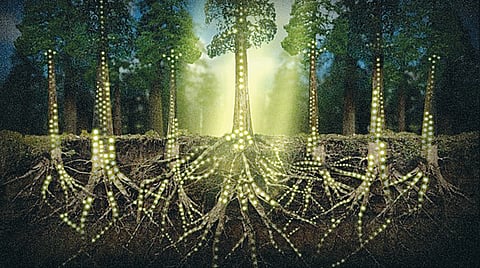

I am going to talk about a particular networking system. One that is not a product of modern times, is primitive in age but remarkable in efficiency. This might be the right time to remind film lovers, of the 2009 blockbuster movie, Avatar. All the organisms are shown to be connected via a type of electrochemical communication system between their roots. Yes, there is philosophy behind this depiction. But there is also physical truth and scientists have found evidence of that.
Think of trees as humans and imagine that they Facebook each other and tweet too! How? Through fungi! Much of fungal bodies are made up of a mass of thin threads known as a mycelium. These threads form the underground ‘internet’, linking the roots of different plants. So the tree in your garden is probably talking right now to a bush several metres away, thanks to mycelia. By linking to the fungal network plants can help each other by sharing nutrients and information, or sabotage unwelcome plants by spreading toxic chemicals through the network. Welcome to the Wood Wide Web – the Earth’s natural internet.
Almost all land plants have mutually-beneficial relationships with fungi, which the 19th-century German biologist, Albert Bernard Frank, named “mycorrhiza”. Fungus colonises the roots of the plant. Plants provide them with food in the form of carbohydrates. The fungi help the plants absorb water and provide nutrients like phosphorus and nitrogen via their mycelia in exchange. When a fungus colonises the plant roots it triggers the production of chemicals needed to boost the defence system of the plant – a phenomenon called ‘priming’. Plugging in to these mycelial networks charges up the plant’s resistance to disease. Mycorrhizae also connect plants that are widely separated.
The process of understanding this system began in 1997, when Suzanne Simard of the University of British Columbia showed that Douglas fir and paper birch trees could transfer carbon via mycelia. Others found that plants could exchange nitrogen and phosphorus as well, using the same route. Thus large trees help small ones using the fungal internet, without which many seedlings wouldn’t survive.
In 2010 Ren Sen Zeng found that when plants are attacked by harmful fungi they release chemical signals into the mycelia and warn their neighbours. In 2013 David Johnson of the University of Aberdeen showed that broad beans use fungal networks to detect impending threats. Johnson found that broad bean seedlings connected via fungal mycelia to seedlings which were under attack by aphids activated their anti-aphid chemical defences, while those without mycelia did not.
Just as any technology can be misused plants get into mischief too. Think computer viruses. In the same way plants’ fungal connections mean that they are never truly alone, and that mischief-making neighbours can harm them. There are plants that don’t have chlorophyll, so unlike most plants they cannot produce their own energy through photosynthesis. Some of these plants, like some orchid species, get carbon from nearby trees via the mycelia of fungi that connect the plants.
Things can be more sinister too. In order to compete with their neighbours for water and light some plants release chemicals that harm their rivals. The American black walnut tree can inhibit the growth of many plants, including staples like potato and cucumber, by releasing a chemical called jugalone from its leaves and roots.
Advertisements have their bad effects too. When plants produce compounds to attract friendly bacteria and fungi to their roots these signals can be picked up by insects and worms looking for tasty roots to eat!
As a result of this growing body of evidence many biologists have started using the term wood wide web to describe the communications services that fungi provide to plants and other organisms. This unique internet system exemplifies one of the great lessons of ecology: seemingly separate organisms are often connected and depend on each other.
But what happens when we tear up these systems in order to install ours? Do plants get weak? Do they get lonely? How would you feel if you were stuck in a room 24x7, without being able to talk to anyone? How would you feel if the best friends you chat with on Skype, got murdered suddenly, in front of your eyes? Perhaps that is how plants feel when we corner them to widen our roads. It is time we acknowledged them as living beings too.